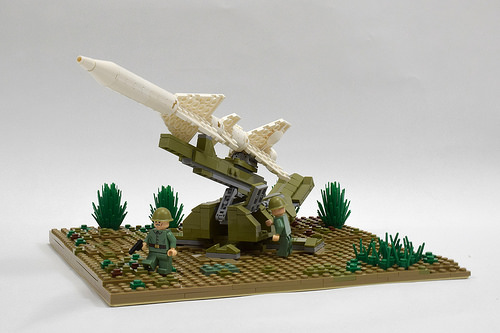From the way pop culture depicts the war in Vietnam, one would think it was all about fighting guerillas, involving lots of helicopters, close combat in jungles or rice paddies and music by the Rolling Stones. However, the US was simultaneously fighting a high-tech war, with US combat aircraft bombing targets in the North and duelling with air defenses of ever-increasing sophistication. Peter Dorbach has expertly recreated some of the North’s main tools in their fight against the so-called “Yankee Air Pirates”: the “Fan Song” guidance radar and a matching missile with its launcher.
These missile systems were part of the Soviet-built S-75 “Dvina” / SA-2 “Guideline” surface-to-air system. The comparison with the minifigs shows the size of these missiles. They had two stages and flew at 3.5 times the speed of sound. They weren’t particularly agile and they could be evaded, but this required careful timing. Initiating the evasive manoeuvre too soon gave the missile time to compensate. Manoeuvre too late and its massive warhead, with a 75 m blast radius, would do its job. S-75 missiles shot down dozens of aircraft during the conflict, with many crew members being killed or captured.
The model is part of a Vietnam War collaboration that will be displayed at BrickFair Virginia this summer. A surface-to-air missile may be a slightly unusual choice of subject, but it is certainly historically significant. The introduction of these systems completely changed air warfare. The S-75 is famous for shooting down Francis Gary Powers’ U-2 spyplane on a secret mission over Russia in 1960, and another over Cuba during the Cuban Missile Crisis in 1962. It is a Cold War classic and amazingly is still in service in about two dozen countries almost 60 years later.


Where’s Jane???? Lol